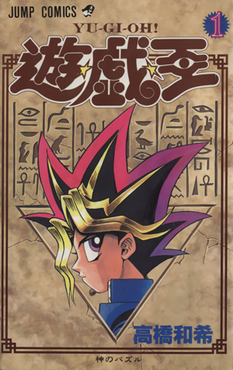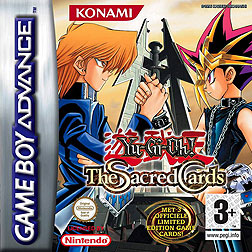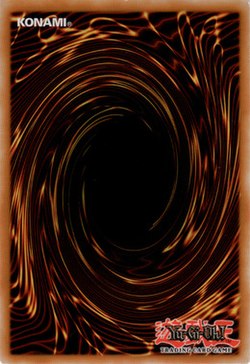
Yu-Gi-Oh! is a Japanese manga series written and illustrated by Kazuki Takahashi. It was serialized in Shueisha's Weekly Shōnen Jump magazine between September 1996 and March 2004. The plot follows the story of a boy named Yugi Mutou, who solves the ancient Millennium Puzzle. Yugi awakens a gambling alter-ego or spirit within his body that solves his conflicts using various games.

Yu-Gi-Oh! World Championship Tournament 2004, known in Japan as Yu-Gi-Oh! Duel Monsters Expert 3, is a card battle video game based on the Yu-Gi-Oh! franchise. This game has been released on the Game Boy Advance system.

Yu-Gi-Oh! The Duelists of the Roses is a video game developed by Konami based on the manga series Yu-Gi-Oh!. The game was released on September 6, 2001 in Japan, and worldwide throughout 2003. The story is a sequel to Yu-Gi-Oh! Forbidden Memories and is loosely based on the War of the Roses. The series' main characters, Yugi Mutou and Seto Kaiba, play opposing teams known as the Lancastrians and the Yorkists. Each team is playable, battling various characters throughout the plot to prevent a ritual summoning by using sorcerous rose cards.

Yu-Gi-Oh! The Movie: Pyramid of Light, later released in Japan as Yu-Gi-Oh! Duel Monsters: Pyramid of Light, or simply Yu-Gi-Oh!: The Movie, is a 2004 animated adventure fantasy film produced by 4Kids Entertainment based on the Japanese manga and anime Yu-Gi-Oh! It stars the cast of the Yu-Gi-Oh! television series in a new adventure that takes place between the third and fourth seasons of the show.

Yu-Gi-Oh! Forbidden Memories, known in Japan as Yu-Gi-Oh! Shin Duel Monsters (遊戯王真デュエルモンスターズ封印されし記憶), is a video game loosely based on the Yu-Gi-Oh! manga and anime series. The game was released exclusively for the PlayStation console in December 1999 in Japan and in 2002 in other regions.

Yu-Gi-Oh! The Falsebound Kingdom is the only GameCube game in the Yu-Gi-Oh! series.

Yu-Gi-Oh! Dark Duel Stories is a 2000 digital collectible card game of the Yu-Gi-Oh! universe for the Game Boy Color developed and published by Konami. The game was Konami's first attempt at a Yu-Gi-Oh! game released in English and the third game in the Japanese Duel Monsters series. This game uses the rules of the previous Duel Monsters games, as opposed to the rules for the Yu-Gi-Oh! Trading Card Game. Players of the game can trade and battle with other players using a link cable.

Yu-Gi-Oh! Worldwide Edition: Stairway to the Destined Duel, later released in Japan as Yu-Gi-Oh! Duel Monsters International, is a Game Boy Advance game based on the popular Yu-Gi-Oh! trading card game and TV series that has the player set during the Battle City arc, dueling popular characters from the anime and manga. The main objective of the game is to build a strong deck from cards won after duels from the main cast from the English second season anime.

Yu-Gi-Oh! The Sacred Cards is a Game Boy Advance game based on the Yu-Gi-Oh! anime developed and published by Konami. It was first released in Japan on July 4, 2002. It was released in North America the following year and in Europe the year after that.
Yu-Gi-Oh! GX Tag Force 2, known in Japan as 'Yu-Gi-Oh! Duel Monsters GX Tag Force 2, is a video game based on the Yu-Gi-Oh! series, developed by Konami and released on PlayStation Portable format in September 2007. This is the second work in the Yu-Gi-Oh Tag Force series.

Yu-Gi-Oh! 5D's is the second main spin-off of the Yu-Gi-Oh! franchise, succeeding Yu-Gi-Oh! GX, in celebration of the 40th anniversary of Weekly Shōnen Jump and the 15th anniversary of V Jump. The series aired from April 2008 to March 2011.
Yu-Gi-Oh! Zexal, stylized as Yu-Gi-Oh! ZEXAL, is a Japanese manga and anime series and the third spin-off of the Yu-Gi-Oh! franchise, after the preceding Yu-Gi-Oh! 5D's. The manga began serialization in Shueisha's V Jump magazine from December 2010 to June 2015 and is licensed in North America by Viz Media. The anime series was produced by Nihon Ad Systems and TV Tokyo, and its animation was done by Gallop. It aired on TV Tokyo from April 2011 to September 2012, with an English-language version airing in North America between October 2011 and August 2013. A sequel series, titled Yu-Gi-Oh! Zexal II, aired in Japan from October 2012 to March 2014 and in North America from June 2013 to January 2016.

Yu-Gi-Oh! The Dawn of Destiny is a strategy video game developed by Konami Computer Entertainment Japan and published by Konami. It was released exclusively for Xbox on March 23, 2004, in North America, November 19, 2004, in Europe, and December 3, 2004, in Australia. It was the first of the Yu-Gi-Oh! franchise on the Xbox. The game has over 1,000 Yu-Gi-Oh! cards and integrates the Yu-Gi-Oh! trading card gameplay and rules with 3D monster battles. The Dawn of Destiny also includes new duel modes such as Link Duel mode and Triple Duel mode, where players can test their skills against three duelists.

Yu-Gi-Oh! Arc-V, stylized as Yu-Gi-Oh! ARC-V, is a Japanese anime series animated by Gallop. It is the fourth spin-off anime series in the Yu-Gi-Oh! franchise following Yu-Gi-Oh! Zexal. The series aired in Japan on TV Tokyo from April 6, 2014 to March 26, 2017. The series is licensed outside Japan by Konami Cross Media NY and launched internationally in 2015.
A sideboard, side deck, or side is a set of cards in a collectible card game that are separate from a player's primary deck. It is used to customize a match strategy against an opponent by enabling a player to change the composition of the playing deck.

Yu-Gi-Oh! Duel Links is a free-to-play, digital collectible card game developed by Konami for the iOS, Android and Microsoft Windows platforms, based on the Yu-Gi-Oh! Trading Card Game. After an initial beta period, the game was first released in Hokkaido, Japan on November 17, 2016, and then released to the rest of the world on January 11, 2017. The Windows version was released worldwide via Steam and in Japan via Yahoo! Japan Games on November 17, 2017.

Yu-Gi-Oh! VRAINS is a Japanese anime series animated by Gallop. It is the fifth anime spin-off in the Yu-Gi-Oh! franchise. The series aired in Japan on TV Tokyo from May 10, 2017 to September 25, 2019. It was simulcast outside of Asia by Crunchyroll courtesy of Konami Cross Media NY. It premiered in the United States on November 3, 2020 on Pluto TV. The term 'VRAINS' derives from 'Virtual Reality' (VR), 'Artificial Intelligence' (AI), 'Network System' (NS). The series revolves around the exploits of the protagonist Yusaku within the virtual world named VRAINS. In addition to featuring previous summoning mechanics, VRAINS introduces the new "Link Summon" mechanic.

Force of Will (フォースオブウィル) is a trading card game. It was originally released in Japan in December 2012 by Force of Will Co., Ltd. and later released to English speaking countries in 2013. Since 2019, the game has been developed by TCG Co., Ltd. and released by Eye Spy Productions. It has game mechanics similar to Magic: The Gathering. The game has a tournament circuit called Grand Prix.

The Final Fantasy Trading Card Game, often abbreviated as Final Fantasy TCG or FF-TCG, is a trading card game developed by Hobby Japan and published by Square Enix. The first iteration was released in Japan in 2011 but never released outside Japan and was discontinued in order to release a second iteration worldwide in October 2016.

Yu-Gi-Oh! Sevens, stylized as Yu-Gi-Oh! SEVENƧ, is a Japanese anime series animated by Bridge that aired in Japan on TV Tokyo from April 4, 2020, to March 27, 2022. It is the sixth spin-off anime series in the Yu-Gi-Oh! franchise, following Yu-Gi-Oh! VRAINS and commemorates the 20th anniversary of the Yu-Gi-Oh! Duel Monsters anime series.

















